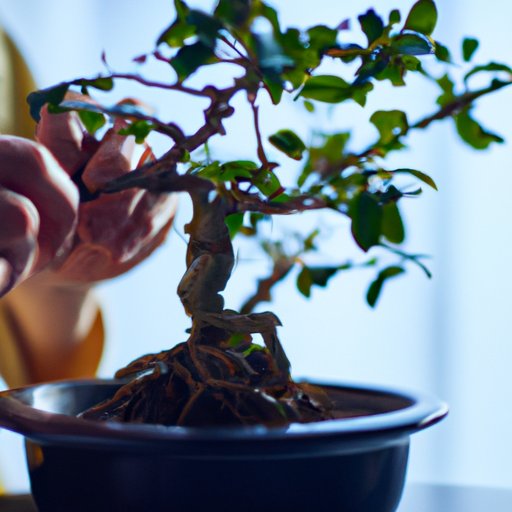Introduction
Bonsai plants are miniature trees grown in containers that mimic their natural counterparts in the wild. They have been around since the Chinese Tang Dynasty (618-907 AD). Bonsai plants are popular among gardeners, as they require minimal space and can be kept indoors or outdoors. With the right care, bonsai plants can live for many years.
Caring for a bonsai plant at home can be both rewarding and challenging. It requires patience and dedication to ensure that the tree remains healthy and vibrant. Taking good care of a bonsai plant can provide numerous benefits, including improved air quality, reduced stress, and a sense of accomplishment.

Choosing the Right Bonsai Plant for Your Home
Choosing the right bonsai plant for your home is essential for its long-term health and vitality. Considerations include the size of the container, the type of soil, the amount of sunlight needed, and the climate of your location. Different types of bonsai plants are suited to different environments. For example, juniper and pine thrive in cooler climates, while figs and ficus prefer warmer climates.
When selecting a bonsai plant, it’s important to note that some species grow faster than others. For instance, junipers and pines grow slowly, while maples and elms grow quickly. It’s also important to consider the shape of the plant. Some plants, such as Japanese maple, are better suited for formal upright styles, while other plants, like azalea, are better suited for informal upright styles.

Providing Adequate Light and Temperature
Bonsai plants need adequate light and temperatures to thrive. During the summer months, bonsai plants should be placed in a spot where they can receive direct sunlight for at least four hours each day. During the winter months, it’s important to keep the tree away from drafts and air conditioning vents, as these can cause the tree to dry out and become stressed.
In addition, it’s important to monitor the temperature of the environment in which the bonsai tree is kept. Bonsai plants should not be exposed to temperatures below freezing or above 95°F. If the temperatures in your home are too extreme, you may need to move the tree to a more suitable location.
Watering Your Bonsai Tree Regularly
Bonsai plants require regular watering to stay healthy and vibrant. The frequency of watering will depend on the type of tree, the climate, and the season. Generally, bonsai trees should be watered once or twice a week during the growing season and once every two weeks during the winter months. When watering your bonsai tree, it’s important to avoid overwatering or underwatering the tree.
To determine when to water your bonsai tree, it’s important to monitor the soil moisture. If the soil feels dry to the touch, it’s time to water the tree. If the soil feels damp, it’s best to wait until the soil has dried out before watering again. It’s also important to ensure that the tree has access to good drainage so that any excess water can escape.

Pruning and Trimming Your Bonsai Tree
Regular pruning and trimming is essential to maintaining the health of your bonsai tree. Pruning helps to remove dead branches and leaves, promote new growth, and shape the tree into the desired style. It’s important to use sharp tools when pruning and trimming, as this will help to reduce the risk of damaging the tree.
When pruning, it’s important to remember that all cuts should be made above a bud or node. This will help to promote new growth and maintain the shape of the tree. Additionally, it’s important to avoid over-pruning, as this can lead to stress and damage the tree.
Fertilizing Your Bonsai Tree
Fertilizing your bonsai tree is important for its long-term health and vitality. Fertilizers provide essential nutrients that help to promote strong roots, lush foliage, and vibrant blooms. It’s important to use a balanced fertilizer, as this will ensure that the tree has access to all of the necessary nutrients during the growing season.
It’s also important to follow the instructions on the fertilizer label. Over-fertilizing can lead to leaf burn and root damage. Additionally, it’s important to avoid fertilizing during the winter months, as this can lead to root rot.
Conclusion
Caring for a bonsai plant at home can be a rewarding experience. By following the steps outlined above, you can ensure that your bonsai tree remains healthy and vibrant. In addition to providing aesthetic beauty, taking good care of a bonsai plant can improve air quality, reduce stress, and provide a sense of accomplishment.
(Note: Is this article not meeting your expectations? Do you have knowledge or insights to share? Unlock new opportunities and expand your reach by joining our authors team. Click Registration to join us and share your expertise with our readers.)
